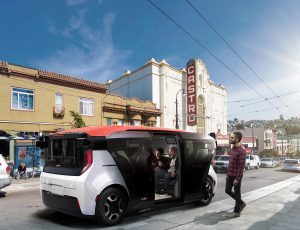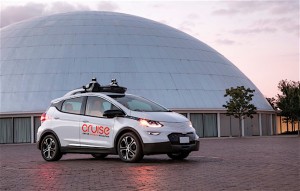General Motors Co.’s autonomous vehicle subsidiary, San Francisco-based Cruise, has obtained a permit to transport passengers in its autonomous vehicles from the state of California.
As part of the program, Cruise must provide data and reports to the California Public Utilities Commission regarding any incidents, the number of passenger miles traveled and passenger safety protocols. Cruise must also have a safety driver behind the wheel and not charge passengers for rides.
Cruise introduced Origin, a fully driverless, without even a steering wheel and pedals for backup, battery-powered people hauler, that will be built at GM’s Detroit-Hamtramck plant along with the soon-to-com GMC Hummer electric pickup truck and other future EVs.
(Cruise reveals Origin of its coming autonomous fleet.)
“As we move closer to launch, we want the opportunity to put top candidates, partners and media into the vehicles and this pilot allows us to do that,” according to Cruise.
However, GM has backed away from its prediction it would have AVs on the road this year but the expectation that the company has emerged as an AV leader has helped prop up the value of its stock. In the meantime, Cruise is on a mission to improve people’s lives by developing “inclusive” transportation.
The company is a success if “people choose to adopt Cruise self-driving, all-electric, shared vehicles in lieu of human-driven, personally owned, single-occupant cars,” said Daniel Kan, Cruise founder in a blog post this week.
(GM, Cruise put San Fran robot-taxi trial on hold.)
“To achieve this, we’ll need an experience that is a far superior ride at a much lower cost than today’s alternatives. To make Cruise work for people, it has to be fundamentally better than anything we enjoy currently,” he said.
“Self-driving vehicles are one of the greatest engineering challenges of our generation,” Cruise notes on its website and while expectations that automated vehicles can move beyond well-defined, geo-fenced grids with minimal traffic challenges have diminished dramatically over the past year.
Cruise is one of five self-driving companies allowed to participate in this program. The other companies with permits are Zoo, Waymo, Pony.ai, Aurora and AutoX, according to Tech Crunch.
(GM’s Cruise Unit Gets Additional $1.15B in New Funding.)
The program is separate from the one run by the California Department of Motor Vehicles, which has granted 66 companies permits to test their respective vehicles in the state, using so-called safety drivers to monitor the vehicle, the Tech Crunch said.



